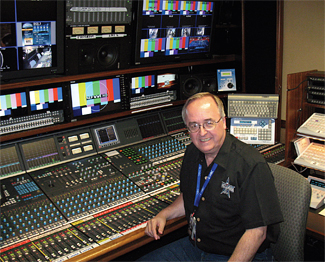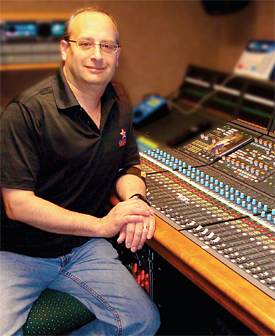The Sound of Sports
LOS ANGELES
Sports broadcast mixers may each have their own favorite microphones and techniques for covering certain events, but ultimately the choice of mics is pretty much dependent on what is available on the remote truck.
"Unless you have some of your own stuff that you like to bring a lot of times you're stuck with what is available," confirmed Dave Grundvig, an independent mixer operating out of Chicago who works events such as the NBA All-Star game and post-season MLB games. "A lot of mixers have their trick bag that they bring."

Randy Flick According to Grundvig, a former recording studio engineer, for his ambience and crowd noise bed, "I tend to like to use more music-friendly microphones that you wouldn't necessarily think of as a sports microphone."
But, he added, "If it's thundering and raining I'm not going to risk putting Neumanns or [AKG] 414s or [Shure] KSM44s outside!"
Grundvig has had some success with boundary mics. "We've put Shure MX391 boundary microphones that were designed for teleconferencing along the whole perimeter of a basketball court on the floor, just outside the foul line. We're able to hear more talking as the players march up and down the court; the squeaks and ball bounce are obviously more defined."
In hockey, he continued, "Quite a number of years ago we did some experiments with Crown PCC [boundary] mics. We hung them high on the glass; eight to 10 PCC microphones on the hockey rink is pretty much standard now."
The comments of the "bleacher bums" at Wrigley Field are typically captured using Shure SM89 shotguns. "Pretty much all the effects mics, in terms of bat crack, dugout mic, are all SM89s at Wrigley Field and Comiskey Park [US Cellular Field]," said Grundvig.
But there is unlikely to be any on-field banter during the season. "People do not like to be eavesdropped," said Grundvig, adding, "During post season we get a little more help from Major League Baseball. We'll put a small Sony parab up, usually with a Neumann KM 184. It's very smooth, very sweet, and the ball pops off the bat and the catcher's mitt."
But, he cautioned, "I tend to not like parabs on baseball, except for doing something in the outfield. I just don't like the way the parabs sound—very mid-rangey—and when you push them hard to reach for something, to me the whole 5.1 collapses."
MOVING AROUND
Phil Adler, a freelancer who works primarily for CBS, has also seen sports governing body decisions affect the mic plot. The new NFL season, for example, is likely to sound rather different.
"For the past 15 years we have had a mic on the umpire, who has been standing in front of the quarterback about 10 yards in front in the defense and that microphone has been getting some amazing sound," he explained.
But the NFL has now moved the umpire, due to the number of injuries that were occurring. "That is going to dramatically change the sound of NFL football," he said. The NFL is providing a mixed feed of several miked-up players, but, said Adler, "We still don't know which players they're going to mic or what it's going to sound like. It will definitely sound different."
Adler works a lot of boxing matches, on HBO, Showtime and USA, relying on Sennheiser MKH416 or MKH70 short shotguns on all four corners, in addition to MKE-2 lavs and Lectrosonics body packs on the trainers, with MKH816 long shotguns on the handheld cameras at ringside. "Sennheiser mics are typically what you'll find as a normal truck complement," he explained.
But with 816s no longer made and harder to find, sometimes he'll reach for an Audio-Technica 4071L: "That's a very nice substitution for an 816."

Phil AdlerBUILDING EXCITEMENT
Any mixer working a boxing match leans heavily on the center overhead mics, he continued. "I've been using the AT825 stereo mic a lot lately."
As Adler noted, "You tend to see the same manufacturers over and over again in broadcast. Sennheiser equipment has been a broadcast staple for one primary reason: the stuff is bulletproof."
That said, he continued, "Audio-Technica has got a lot of nice specialty stuff, stereo mics especially, that have been just wonderful in the field. In some cases they have product that's better than Sennheiser or that Sennheiser doesn't have in their product line. My personal stash is a combination of A-T and Sennheiser."
Adler is not a fan of single point source mics. "I would rather take more of the entertainment approach and pepper the place with a bunch of microphones. I'll build my own soundfield. The trick is, how do I capture as much of the excitement of the building as I can get and still make sure things are clear and that you can hear the commentators."
Randy Flick, the primary mixer on HBO Boxing, also handles WWE wrestling, which requires somewhat different mics and techniques. "We usually get a lot of guys crashing onto the mat so we use a pair of Shure KSM32s. It's like miking a 20-foot bass drum," he reported.
"We also use a lot of Shure UR2 RF hand mics with SM58 capsules. We have 14 of those that we can press into action at any time."
Handheld cameras are each mounted with an A-T BT4027 stereo long shotgun. "It's not disposable, by any means, but the cameramen take a beating down there at ringside. They're in the mud, the blood and the beer!" laughed Flick.
As for crowd ambience, on the wrestling tour, a Holophone H2 Pro is recorded along with multiple pairs of MKH416s. "There are about 10 microphones in the crowd mix," he said.
But while wrestling announcers continue to use Sennheiser HMD 25 headsets, said Flick, HBO Boxing tour announcers have switched to the HME 26(4). "We've been using those for the last couple of months; we've been really happy. The 26 with the condenser just sounds better. You don't have to do as much work with the EQ to make them sound really nice and natural."
Get the TV Tech Newsletter
The professional video industry's #1 source for news, trends and product and tech information. Sign up below.
Steve Harvey began writing for Pro Sound News and Surround Professional in 2000 and is currently senior content producer for Mix and a contributor to TV Tech. He has worked in the pro audio industry—as a touring musician, in live production, installed sound, and equipment sales and marketing—since November 1980.
